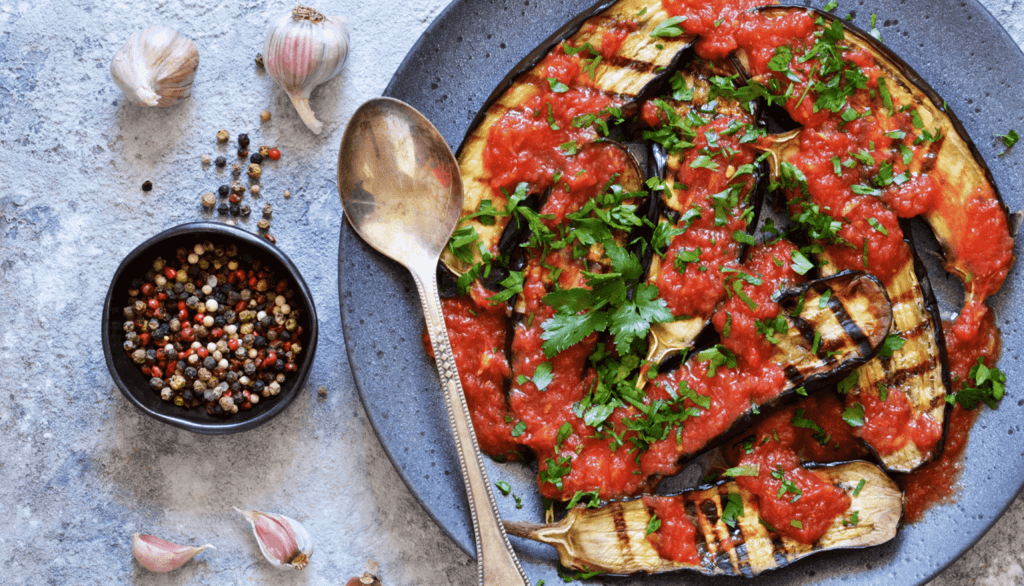Perfect coleslaw and roasted eggplant share this salty secret

In this six-part blog series, I’ll share interesting and practical cooking insights that I learned from HarvardX’s Science & Cooking: From Haute Cuisine to Soft Matter Science (chemistry). I’m a scientist who loves cooking, and working from home and having lots of free time, has allowed me to bring my two passions together. Bon appetit!
I love eggplants and love to order dishes with eggplants in restaurants, but when I tried to prepare them at home I had bad experiences with my dishes tasting bitter and unpleasant.
Many chefs follow a simple procedure to prevent that bitter taste. Cut the eggplant in slices or cubes, cover a strainer with a layer of the eggplant and then cover the eggplant with a layer of salt. Add another layer of eggplant and another layer of salt. Add some weight to the top by using a bowl with water. Finally, place a container under the strainer to collect the produced juices. Leave it to rest for 30 minutes, and there will be a brown-violet liquid draining.
 After 30 minutes, clean the eggplant with a dry paper towel to eliminate the excess of salt and cook. (Don’t forget to eliminate the excess salt! I forgot the first time, and I ruined the dish). Salting the eggplant slices or cubes draws out juices that contain anthocyanins, among other molecules, that add bitterness to the eggplant. This process also tightens and firms up the flesh, making the eggplant less likely to soak up as much oil, and it also seasons the eggplant by penetrating the flesh.
After 30 minutes, clean the eggplant with a dry paper towel to eliminate the excess of salt and cook. (Don’t forget to eliminate the excess salt! I forgot the first time, and I ruined the dish). Salting the eggplant slices or cubes draws out juices that contain anthocyanins, among other molecules, that add bitterness to the eggplant. This process also tightens and firms up the flesh, making the eggplant less likely to soak up as much oil, and it also seasons the eggplant by penetrating the flesh.
Eggplants, as any other vegetables, are composed of ~80% water. The membranes of the cells prevent the water from leaving the plant, although the eggplant is permeable to water. When salt is added to the eggplant, water is forced to come out from the inside of the cells. This happens because when the concentrations of salt, in this example, is different in two areas that are in contact with each other by a permeable membrane, the substances will diffuse from one side to the other of the membrane until the solution is uniform throughout the whole area. This will cause the total volume of water on each side of the membrane to change: the side of the membrane with more salt will end up with much more water. This water also will carry some other soluble components. This can lead to problems for cells, such as bursting, if too much water moves into the cell, or becoming dehydrated, if too much water moves out.
A similar effect happens when preparing coleslaw: The salt added to the salad in the dressing will draw water from the cabbage. The perfect coleslaw recipe calls for cutting the cabbage and onions and grating the carrots. Mix all the ingredients in a bowl with a lot of salt, place them in a strainer with a container under to collect the produced juices. Leave to rest for 30 minutes, eliminating at the end the excess salt and water by pressing the mix of vegetables between 2 paper towels. Prepare the dressing in a big bowl by typically whisking together sugar, pepper, milk, mayonnaise, buttermilk, vinegar, and lemon juice until smooth (although you can find a dressing recipe online that looks good to you). Add the drained vegetables and mix until blended with the dressing. Refrigerate at least 2 hours before serving.
Enjoy!
